Podcast: Play in new window | Download (Duration: 31:39 — 35.7MB)
Subscribe: Apple Podcasts | Google Podcasts | Spotify | Amazon Music | Android | Pandora | iHeartRadio | JioSaavn | Podcast Index | Email | TuneIn | RSS | More
By Davy Crockett
![]()
![]()
Both a podcast episode and a full article
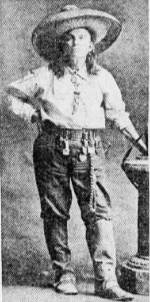

On May 10, 2019, America will celebrate the 150th anniversary of the completion of the transcontinental railroad. This is the second article in a series to recognize some historic accomplishments walking or running across the American continent. In the previous article, the history was given of the 1855 walk across South America by Nathaniel Holmes Bishop that inspired others to try transcontinental walks.
Starting around 1890, dozens of “pedestrians” attempted transcontinental walks and many claimed to have succeeded. In 1896 a Buffalo article commented, “No less that a score have passed through Buffalo within a year.”
But did these walkers really accomplish these journeys all the way on foot? Verification was impossible in those days, Walkers wanted to succeed at all costs and were motivated by large wagers and the potential for great fame. Even in more modern times there have been fraudulent attempts and claims. Some of these very early walks that received attention may have been legitimate, but with careful analysis of the evidence left behind, most of these early transcontinental walks were likely hoaxes. The Buffalo Enquirer further stated in 1896, “Dead broke pedestrians have lived off gullible hotel keepers and charitably-inclined residents of the various states through which they pass. The American people like to humbugged.”
It wasn’t until about 1909 that more of the press started to accept the fact that many of these walkers cheated. One reporter wrote, “Several alleged walks across the continent have been heralded from time to time, but their accuracy has been so vague as to be valueless for records of bona fide achievements.”
Faking Transcontinental Walks
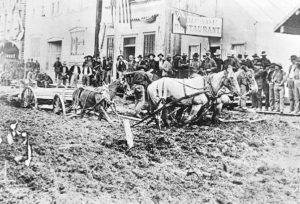

Using a pack horse or having a rider along on a horse providing aid was possible, but not practical because the horses would need to be changed out. Those who claimed to do it solo without a pack horse, or without a rider, were very likely frauds.
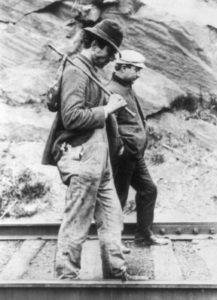

Newspapers frequently covered these attempts, but because communication and verification were poor, it was very simple to fool the public and the press, performing fraudulent transcontinental walks. In 2019, with so many old digital newspapers available, it is fairly simple to track an early walker’s travels reported in the papers and stitch the stories together to determine fact or fiction.
The story of Dakota Bob is a great example to examine and illustrates the reality of most transcontinental walks before 1910. Dakota Bob was a colorful figure who became very famous in the East. During his walking career, he walked across the North America continent eight times or more! Or did he? Here is the story of Dakota Bob.
Dakota Bob
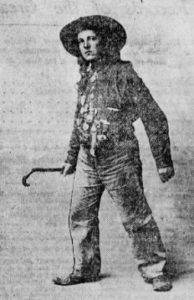

It is believed that George A. Osborne “Dakota Bob” was born near Buffalo, New York on March 10, 1856. His true life history is a mystery because the only source was from him. It may be true, it may not be. Details shifted over the years, but this early life history was told fairly constantly.
Dakota Bob came from a good family. He attended college at Cornell University but felt a yearning to go west and “ran away.” He claimed that he was adopted by the Indians, lived among the Sioux for thirteen years, and was part of Sitting Bull’s family. When he left the Indians, he became a lumberman and then an Indian scout. “With a record as a gun fighter and a crack shot, Dakota Bob was for a long time range guard for some of the wealthiest cattlemen in the western country. He encountered many hair-raising and spine-chilling experiences.” In the 1880s, he returned to Buffalo, New York, and worked as a newspaper reporter.


Dakota Bob was at the Sioux’s Pine Ridge Indian Reservation when hostilities broke out during the Sioux uprising in 1890-91, and served as a reporter and scout for the Army. He frequently carried messages between South Dakota and Nebraska in the soles of his shoes for General Nelson A. Miles (1839-1925), the commander of the U.S troops.
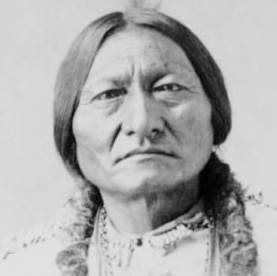

Dakota Bob claimed that he was at the 1890 Battle of Wounded Knee when Sitting Bull was killed, but his account of the event didn’t match the historical facts. He wore a medal that he said was presented to him by the government for his gallant service and fine marksmanship during the Indian wars. He received numerous serious wounds from the Indians and showed scars. He was given the name Dakota Bob by Buffalo Bill Cody who he worked for at one time in his western show. Later Dakota Bob never shared his real name.
1897 – San Francisco to New York
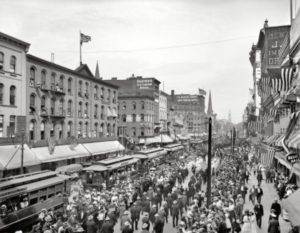

As transcontinental walks started to be covered in newspapers across the country, Dakota Bob claimed that on January 1, 1897, he started to walk without a cent from San Francisco to New York on a wager of $3,000. Out of the blue, he appeared in the news for the first time in May 1897, in Buffalo, New York, stating that he was finishing up his transcontinental walk.
The newspaper reported, “His clothes were greasy and his dark oily looking locks hung from underneath a Western sombrero and floated down his back. On his shoulder was a pink-eyed white rat and around his neck he wore a necklace made from molar and incisors which in happier days had comfortably nestled in the mouths of the best citizens of towns in the West.”
Dakota Bob came to the Buffalo Courier newspaper office and said, “I’m Dakota Bob and I’m here to let you fellows know something about me. I’m an old Buffalo boy and I know more about this town than the man who made it.” He then said some unkind things about some well-known people in the city. “Finally, his whisky laden breath became monotonous and he and the grease, teeth, and rat were ushered into outer darkness.” Even with this poor first impression, Dakota Bob was successful in speaking to well-attended paying spectator gatherings.
On July 20, 1897, after a claimed eight months, Dakota Bob showed up in New York City, claiming that he walked across the country and had worn out fifteen pair of shoes.
There are many red flags with Dakota Bob’s transcontinental walk claim. During that time, newspapers in the west were fascinated by such stories, but contained complete silence about his first transcontinental walk. It supposedly took him more than 2,500 miles to be first introduced to the public at Buffalo. Dakota Bob claimed that he carried no baggage with him, just a knapsack. He said that he never begged or asked for charity, that he worked as he traveled by giving lectures. Using that no-aid approach for crossing the remote western states would have been an impossible strategy, but the Eastern press had no idea. He claimed that he started his walk in the dead of winter but never mentioned how he crossed the snow-bound Sierra and Rockies solo on foot.
1897 – New York to San Francisco
Just five days later, on July 25, 1897, Bob started a return trip on another wager that required him to return to San Francisco in only four months, half the time of his alleged first trip. His wager sources were always curious. The bet was usually for $3,000 and involving the same men, his best friend, William Lee of Yonkers, New York, and a Joe Mills of Portland, Oregon. The betters seemed to never worry about verification, and the terms of the wager changed on the fly as Dakota Bob traveled. It is believed there never were wagers for or against him, that it was just the story he gave to explain why he was walking to impress people.
After three weeks, on August 20th, he was in Buffalo, New York and an article reported, “Bob dresses like a scout or cowboy. His hair is long and he is covered with mementos of various kinds. He has among other things, a necklace made of wire on which are strung 120 white men’s teeth. This necklace was obtained from an Indian on the Cheyenne reservation while Bob was on his way east.” He carried a book filled with signatures from officials of the cities he passed through. For all his walking career, he always had his books along and it was his source of verification. In cities he would seek out mayors or other city officials to sign or stamp his book. He would gain their trust and get hired to give lectures.
How did Dakota Bob actually arrive in the towns to get these signatures and stamps? With the hundreds of articles written about him over the years from dozens of towns, not once was there an article that included an eye witness that he walked by their farms and was invited to stop. He was only seen in the towns and cities. He most likely arrived on trains and probably used the hobo method of traveling on freight trains.
On this walk, despite the four-month arrival requirement, Bob didn’t seem to be in much of a hurry, staying at Buffalo for three days to lecture, get money, and attend events. In October, three months into his journey, he arrived at Fort Wayne, Indiana and said he was represented by the New York Illustrated News and now planned to finish in January. It is strange that that the wager was changed from four to six months. In November he had only made it to Illinois and the newspaper called him a “freak.”
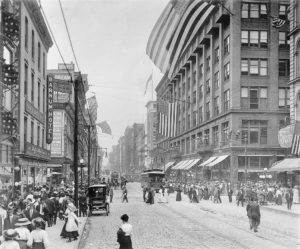

A month later, four months in to his walk in December 1897, Bob was in St. Louis, Missouri, clearly in no hurry. “With his big hat, his long hair falling over his shoulders, his coat covered with medals and a necklace of panther’ teeth about his neck, he attracts much attention.” He even claimed falsely that he had made a half dozen previous transcontinental pedestrian trips. He changed his story again and said he planned to arrive in San Francisco in July, a year from his start. He said he stops in each town two days and in each city four days and earns money by ‘passing samples and advertising matter.” The St. Louis article was the last one for seven months.
Where did Dakota Bob spend the winter? Did he wait for spring until continuing over the mountains? There were no stories about in the western newspapers. Finally, in June 1898 he was in the news again! Was he nearing San Francisco? No, he showed up in Indiana claiming that he was on his way back to New York!
1898 – San Francisco to New York


Muncie, Indiana was convinced Dakota Bob was legit. His book even included stamps from foreign countries. The newspaper mentioned, “The man is a fluent talker of various languages and in no doubt the genuine and original “Dakota Bob.” Going through upstate New York, it was mentioned that he traveled with his dog, “Nero” and his manager Charles Ohms. One city he scammed wrote, “He will be in the city all day and the small boys can feast his eyes on this product of the plains.”
On September 17, 1898, Bob showed up in New York City proclaiming that he had finished walking to San Francisco and back. But no one in 1898 knew that his story was false. Instead he was treated as an amazing hero for little boys to look up to. He claimed that he had now walked across the continent four times and held the fastest time ever of six months and 19 days. (Others had claimed in earlier years doing it in about half that time.)
1898 – Philadelphia to San Francisco
Dakota Bob had a good scam going that he didn’t want to see stop. Just two weeks later in October 1899, he started a purported journey to walk from Philadelphia down the Atlantic coast, and through the gulf states to San Francisco by July 1, 1899. In December he was in Atlanta telling a tale that recently he had to jump 150 feet off a railroad bridge because a train was coming. In January he was in Florida, and February in Mississippi. In May, 1899, he was back in New Orleans, stating that he had given up on the transcontinental walk because his primary sponsor died. He disappeared from the news for a year.
1900 – San Francisco to New York – Changed to Portland OR, to Portland ME


One newspaper reporter called him a “poser.” “Dakota Bob is in town again, with more hardware dangling from him than he had last time he was here.” In Fort Plains, New York, they were catching on. “Dakota Bob, the long hair beauty who thinks or pretends to think that he is constantly walking from this, that or the other place. By the manner in which he manages to dodge real work, it’s safe betting that he is a tramp. If the people would stop making heroes out of those cheap guys of the Dakota Bob genus, this wager walking racket would soon peter out.”
But he didn’t stop, he wanted to extend his scam into New England so just two weeks later he changed his story and said he was finishing a walk from Portland, Oregon to Portland Maine. He said he started in Oregon on Christmas Day, 1899 and needed to finish in Maine on August 1st. After fooling various New England cities, he showed up in Portland Maine on the very day his phony bet required, and he said he won $2,000.
1900-1901 – New York to Mexico City and Back
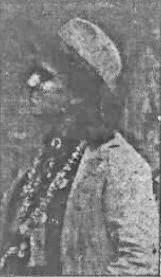

The next month, in September 1900, Dakota Bob was in Philadelphia claiming that he left New York City on August 24, 1900 and was on his way to Mexico City and back!
After two months In October-November he spent a month giving lectures and putting on shows in North Carolina. In December he took his fraudulent, but colorful lectures to Atlanta, Georgia where he spent several days because he said he was ahead of schedule. The Atlanta Constitution reported, “Dakota Bob would attract a crowd anywhere. He looks as if he just stepped from the canvas of a western picture. He is rather small in statue, but does not carry a surplus ounce of flesh upon his well-knit frame. His face is swarthy, and a mass of long black hair, with here and there a silver strand, covers his head. His hair is parted Indian fashion in the middle. A blue flannel shirt covers his broad chest, and his coat fails to conceal a single one of his seventeen medals, buttons and charms which are suspended from his shirt front. His only luggage is a small satchel, and in this he carries books of clippings from all parts of the country, cards of hundreds of prominent people.”
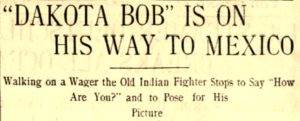

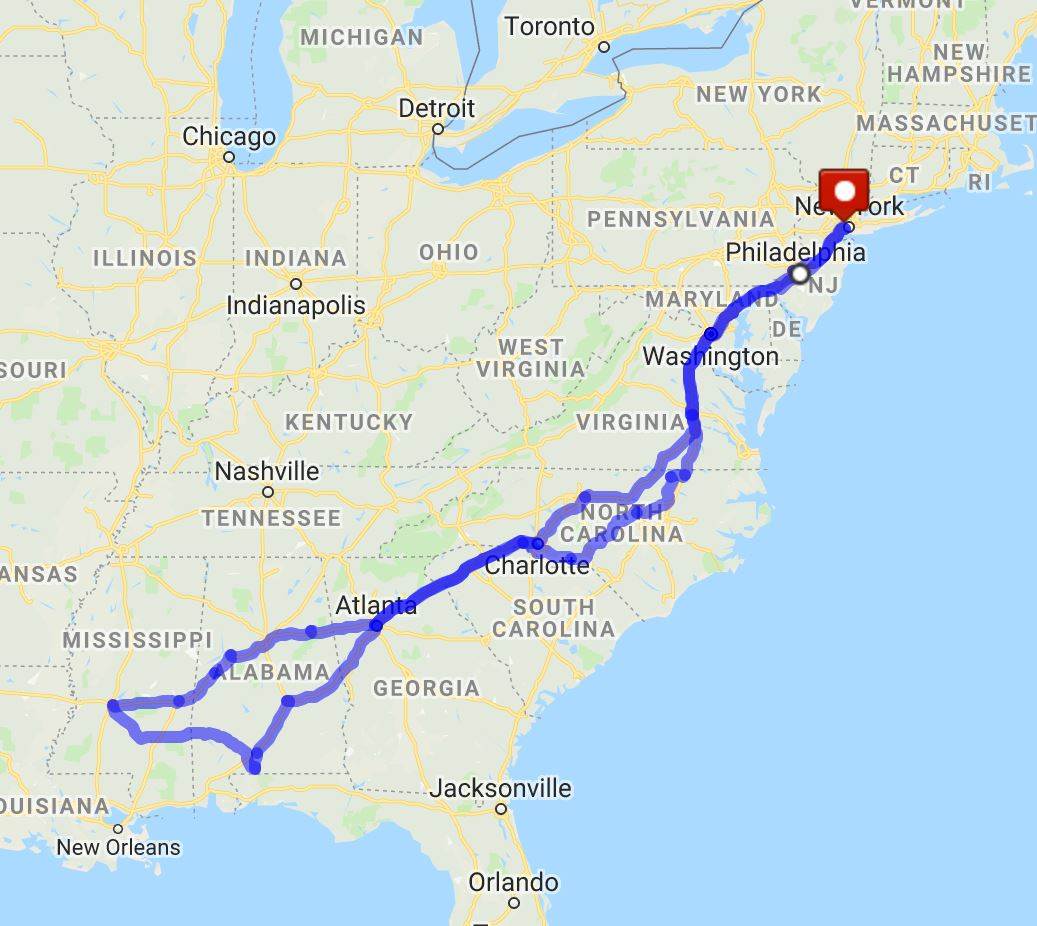

However, in Anniston, Alabama, he was caught. Their newspaper reported, “Dakota Bob, the long distance walker of America, who has already walked from New York to the city of Mexico and this far on the return trip, as he says, didn’t walk out of Anniston this morning according to the program. He was a passenger on an east-bound train.” Word got out. Another Alabama paper called him a “fake pedestrian.” But he continued on with his fake walk to North Carolina where he said he walked ten hours per day and slept nine hours each night. He showed people the fake seal he claimed to have received from Mexico City.
Ten days after being in North Carolina, He showed up about 550 miles away in New York City, finishing up what he claimed was a 6,300-mile journey to Mexico City and back in just 8 months. He would have had to average walking 787 miles per month!
The 1901 Pan American Exposition
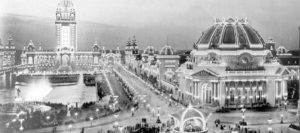

Dakota Bob kept telling people that a 1,000-mile competition had been arranged against a champion walker from France and that he would be sailing for Paris. First it was said to be scheduled for July 1901 and then for October. But Dakota Bob didn’t sail. Instead he went to the Pan-American Expo (World’s Fair) in Buffalo.
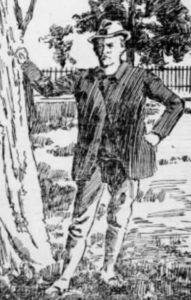

He then issued a challenge to a famous German walker, Gustav Koegel of Germany to come to American and compete against him for 1,000 miles at the Exposition. Koegel replied publicly, “This Dakota Bob is a bluffer, and he has no intention of meeting me in a contest. I am champion and he knows it.” No competition took place.
Koegel claimed that he walked around the world in 1894-96 taking two years. In 1896 after completing that walk, Koegel allegedly did a transcontinental walk from Los Angeles to New York, trying to break the record of 92 days. He walked solo with a canteen, carried very little, stopped to lecture in cities, and carried books that were stamped along his route by mayors which always took a lot of time. Clearly Dakota Bob had copied Koegel’s approach. In analyzing Koegel’s 1896 transcontinental walk of about 113 days, it is pretty obvious that it is fraudulent, especially crossing the Sierra and the Nevada desert in the heat of the summer at a pace of 50 miles per day. Very few city newspapers had stories about him walking in their cities.
On September 21, 1901, the Buffalo Times revealed Dakota Bob’s real name, George Osborne who 20 years earlier worked for the Buffalo Sunday Times. Osborne was currently working for a museum of anatomy at Buffalo and stood in front of the shop peddling posters “and being altogether extraordinary in appearance.” Dakota Bob dropped out of the news for a year.
1903 – Tearing it Up
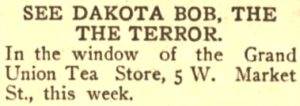

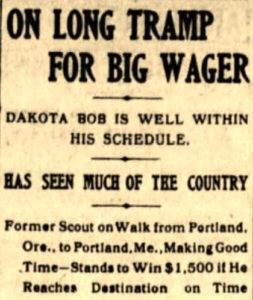

In 1907, Dakota Bob, now 51 years old, was back doing his fake transcontinental walks. He showed up in Indiana out of the blue on August 7th, claiming that he left Portland, Oregon on March 10, 1907 and was on the way to Portland, Maine. There had been no news coverage before Indiana. This time, Dakota Bob said 20-mile rides were allowed on each rainy day. What? He likely had been caught taking rides and this was his cover story. He finished his “walk” at New York on Nov 20, 1907 and won that wager of $3,000. A wager that allowed for rides? Somehow the destination of the apparent phony wager also shifted from Portland Maine to New York City.
1908 – New York to New Orleans
Immediately, Dakota Bob started another fake walk on November 20, 1907 from New York to New Orleans in time for Mardi Gras, and then would continue “back” to Portland Oregon. He claimed to be a rival of the famous pedestrian, Edward Payson Weston and falsely told people that his recent transcontinental walk ended in Portland, Maine. (He never went to Portland, Maine)
His new idea was to say that he was walking in a circle around all the United States in fifteen months. But he spent more than a month giving shows in North Carolina. He then appeared in Alabama and then took a detour to Nashville, Tennessee. He said he was in a hurry to visit his aged mother in California, but he spent a lot of time giving shows and taking detours to visit with mayors and governors.
![]()
![]()
1908 – Portland, OR to Portland, ME
Two months later, In July, 1908, he was back to his favorite city of Buffalo, telling people he was again finishing a walk from Portland, Oregon to Portland Maine. He told the same story three days later in Rochester, New York.
On August 21, 1908 in New Jersey, Dakota Bob said he was “the only genuine champion continent walker.” He said, “I always travel at night. Only greenhorns at this game ever attempt to buck the sun this season of the year. I carry no baggage, shipping my stuff ahead. During the day I sleep usually beneath a tree along the road. I make my living tearing paper into fancy designs, doing sleight of hand tricks and other stunts.” He said this would be his last trip. Dakota Bob didn’t continue to Portland, Maine. A day after being in New Jersey, he showed up in Philadelphia, his journey apparently complete. He now said his career walking miles were 74,600 miles.
1908-09 Washington D.C. to Mexico City and Back
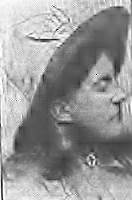



Dakota Bob showed up in Tampa, Florida in January 1909, still claiming to be walking toward Mexico City. (In later years he claimed he arrived in Mexico City on December 31st). The Tampa newspaper was puzzled, “Tampa is a great way out of his route” but said Dakota Bob couldn’t resist to visit a city he had heard so much about.
Dakota Bob spent February and March scamming his way through Florida, visiting many cities. Six months into his walk, he was in Pensacola on March 6, 1909, and two weeks later he was in Alabama telling newspapers that he was on his way back from Mexico City! Apparently he walked more than 3,000 miles in two weeks!
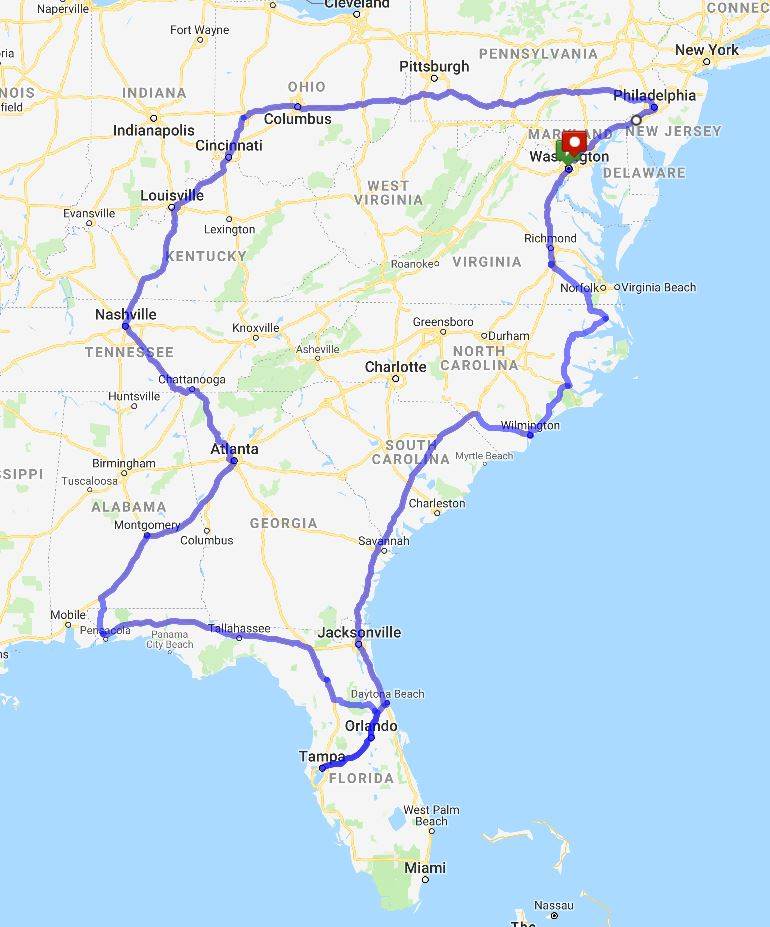

When he arrived back in Atlanta, Georgia on April 9, 1909, he told the tale of his walk to Mexico City and back. He said his career walking miles were 86,400, jumping 12,000 miles in just a half year. On May 10th he arrived at Nashville and said he was caught in their recent tornado and suffered severe injuries. But he was determined to finish his walk to Mexico City and back. He showed people the fake seal of the Republic of Mexico that he said he received from Mexican President Diaz which he planned to deliver to President Taft.
In June Dakota Bob was in Dayton Ohio, still claiming to be heading back to Washington D.C. from Mexico. Sadly, he kept up the hoax and about August 20, 1909 arrived in Philadelphia and it was reported, “During his stay in the Mexican Republic, Dakota Bob was the guest for several days of President Diaz, from whom he obtained a letter as well as an impression of the seal of the Republic of Mexico which he will deliver to President Taft.”
On September 18, 1909, Dakota Bob finished his curious journey and arrived back at Washington D.C. He claimed that he had walked 4,600 miles. There was no mention that he actually wintered in Florida. Thankfully it appears he never met with Taft or his staff, but he said he gave the fake letter to the postmaster to deliver.
1910 – 7,000 Mile Walk Around the States
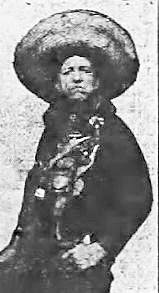

In October, 1909, a newspaper in Raleigh, North Carolina proclaimed that Dakota Bob was the “World’s Greatest Walker” when he visited the State Fair Grounds. He said his lifetime walking miles were now at 93,000 miles and that he had walked more miles than any other living man. “He is attired in a long tailed coat, of which the lapels and front are gaily decorated with medals and emblems, given him in many cities. His head, from which long locks suspend is covered with a gigantic sombrero.” He next planned to do a 7,000-mile walk to reach a total of 100,000 miles by circumnavigating the states.
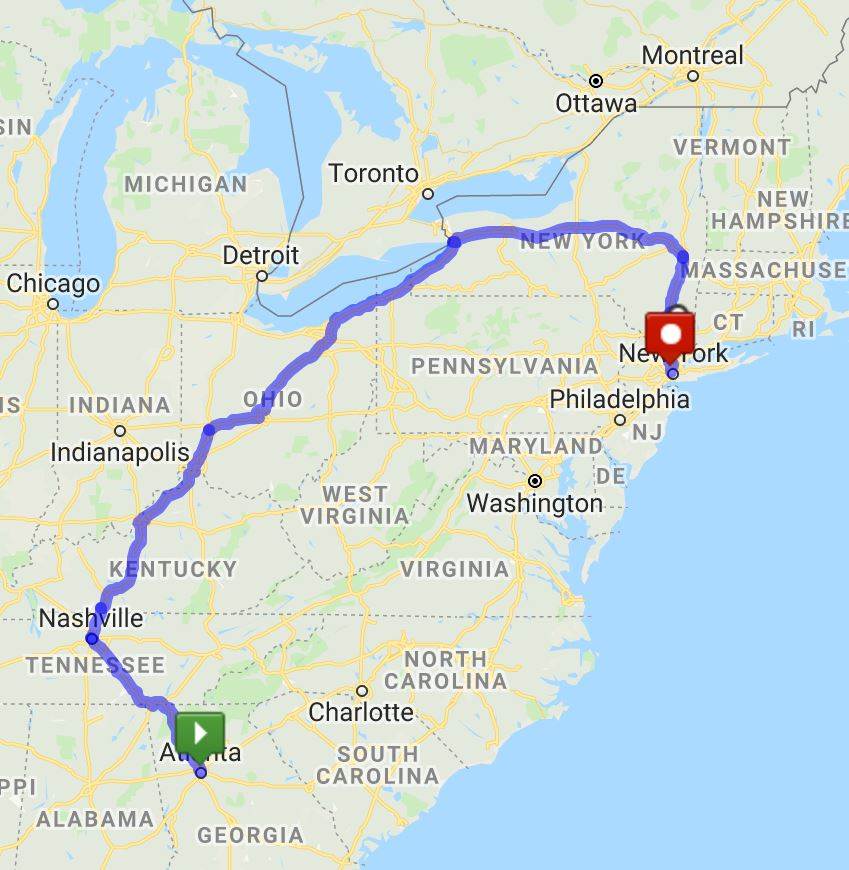

In March 1910 he was doing entertainment in Atlanta talking about doing a walk from Atlanta to San Francisco soon. But in April, he was in Tennessee and Kentucky and claimed that he had started a 7,000-mile walk circumnavigation around the country from Tampa, Florida on January 15th, 1910. A new twist to his journey is that a group of musicians were accompanying him. They would put on entertainment and Dakota Bob would give short talks about his travels. He would usually stay in each city several days. It is a wonder that no one challenged him on when he would actually walk.
Just two months later In May, he was at Dayton, Ohio heading east and then made it to Buffalo, New York by the end of the month. The newspapers seem bored by his appearance again. At Poughkeepsie, New York he wore a coat that he said was presented to him in Mexico. He said he was heading to visit with his friend Teddy Roosevelt. Arriving in New York City, Dakota Bob claimed that he had already finished up his 7,000-mile walk. It was truly an amazing walk! Somehow he walked 7,000 miles in only five months and he was only seen in five Eastern states, staying multiple days in each city. He now claimed 100,000 career miles walked.
With that great “accomplishment” Dakota Bob claimed to have many offers to go into vaudeville and that Coca Cola wanted to hire him for advertising. In October he was seen coming into Washington D.C. in disguise. He then put on his normal costume and went into the Washington Post office to “say nice things about himself.” He said he was “the champion long-distance walker of the world” and that he now had accomplished six transcontinental walks, that he has walked every inch of the distance and had not ridden on a train in 25 years. He also wildly claimed, “I haven’t been in a wagon or an auto. I hate autos.” He said his best walk was 6,400 miles to and from Mexico City. One paper wrote that “he is the champion, because he says so himself.” He claimed six transcontinental walks, but actually this analysis shows that he faked at least eight..
Retiring From Walking
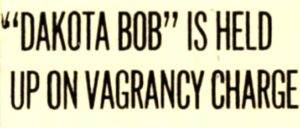

In September, 1912, Dakota Bob was in Atlanta and said back in May he was struck by an automobile in Buffalo, New York and one of his legs was broken. His walking days were over. He now said he traveled by train and was heading to Porto Rico for the winter. He gave the same story later in Tampa and claimed that he had walked 125,000 miles in his walking career. Wow, in just 16 months, he added 25,000 more miles. He planned to go into vaudeville or movie pictures. He was hired by the circus for a time and performed well.
In 1914, Dakota Bob was living in Tampa, Florida working for the Tampa Tribune, selling papers. He was destitute and kindly was allowed to live in the press room, making a bed on tables. One day he stole a judge’s raincoat and disappeared but eventually returned. At age 58, they called him an “aged man.” He was sent to live on a poor farm, twice running away, and wandered the streets for days and then returning to the Tribune.


His sad obituary included, “But now all mundane trials and tribulations have ceased, and his weary bones are at ease, in a grave sheltered by lofty trees, where always stirs a wanton breeze.”
Dakota Bob’s fake walking career sadly was not an anomaly. This was written not to single out Dakota Bob, but as an example of what the walking environment was at the time. Many other walkers and runners of his era did similar things to gain attention and earn a living using deception in our sport. Even sadder, still today some runners have taken up the Dakota Bob banner and cheated running accomplishments. Some runners and hikers of today try to claim fastest known times on transcontinental runs, through hikes such as the Appalachian Trail, and to establish course records, all seemingly for social media fame and glory. Technology is helping to finally push away this deception.
Read the entire transcontinental series:
- 1855 Walk Across South America
- Dakota Bob – Transcontinental Walker
- Zoe Gayton – Woman Transcontinental Walker
- The Wheelbarrow Man – Lyman Potter
- Edward Payson Weston’s 1909 Walk Across America
Sources:
- Helena Weekly Herald (Montana), Jul 12, 1877
- The Daily Ogden Junction (Utah), Dec 29, 1878
- Minneapolis Independent (Kansas), Mar 22, 1879
- The Saline County Journal (Kansas), Apr 3, 1879
- New York Daily Herald, Jul 25, 1879
- The Brooklyn Daily Eagle, Jul 25, 1879
- The San Francisco Call, Jul 21, 1897
- Democrat and Chronicle (Rochester, New York), Aug 17, 1897, Aug 13, 1898
- Buffalo Morning Express, August 20, 1897
- Fort Wayne News (Indiana), Oct 5, 1897, Apr 4, 1900
- St Louis Post-Dispatch, Dec 4, 1897
- The Muncie Daily Herald, Jun 23, 1898
- Buffalo Courier, Aug 1, 1898, May 21, 1900, Aug 30, 1901
- Poughkeepsie Eagle-News, Sep 8, 1898
- Trenton Evening Times, Sept 29, 1898
- The Times-Democrat (New Orleans), May 11, 1899
- Poughkeepsie Eagle-News, Jun 23, 1900
- Portsmouth Herald, Jul 23, 1900
- The Atlanta Constitution, Dec 7, 1900
- The Anniston Star, April 4, 1901
- The Buffalo Times, Sep 11, 1901, Sep 19, 1907
- The Times-Tribune (Scranton, Pennsylvania), Nov 18, 1903
- The Weekly Republican, Aug 8, 1907
- News and Observer (Raleigh, North Carolina), Jan 29, 1908
- Buffalo Courier, Jul 7, 1908
- The Gaffney Ledger (South Carolina) Sept 24, 1909
- The Tennessean, Apr 2, 1910
- The Franklin Favorite (Kentucky), Apr 14, 1910
- Buffalo Times, 26 May 1910
- Tar Heel (North Carolina) 15 Jul 1910
- The Washington Post, Oct 11,1910
- The Tampa Tribune, Jan 26, 1911
- The Dayton Heral, Apr 14, 1911
- Democrat and Chronicle, May 25, 1911
- The Tampa Tribune, Oct 27, 1911
- The Troy Messenger (Alabama), Feb 28, 1912
- The Atlanta Constitution, Sep 29, 1912
- The Tampa Tribune, Oct 8, 1916
